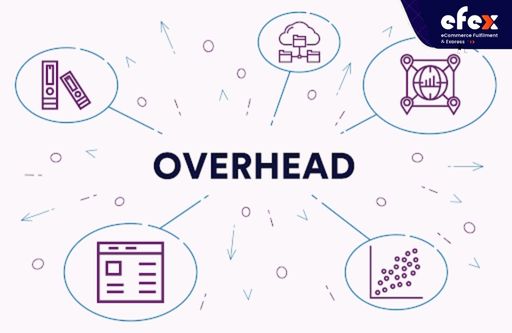
More Helpful Content
There are numerous expenses associated with operating a company, such as operational fees and taxes. Making things isn't cheap at all times. There are manufacturing overhead costs that company owners must manage in a manufacturing operation. In this post, we will look at the many types of manufacturing overhead and how you can cut these costs to improve productivity. Let's explain manufacturing overhead, then examine the manufacturing overhead formula and learn how to calculate it.

Manufacturing overhead is any expenditure that is not directly tied to the production of a facility. Manufacturing overhead indirect costs are also known as production overhead, factory overhead, or factory burden.

Direct costs, such as the cost of materials and employees, are directly tied to a facility's manufacturing operations and thus are not included in manufacturing overhead.
👉 Read More: What Is Fixed Manufacturing Overhead: Formula And Example
👉 Read More: What Is Variable Manufacturing Overhead? Example And Formula
👉 Read More: What Is Variable Manufacturing Cost Formula And Calculation
Manufacturing overhead consists of five primary types of costs, which are as follows:
Indirect Labor costs are expenses incurred by the company for staff who are not involved directly in the manufacture of the product. Security guards, cleaning staff, machine repairers, site supervisors, managers, and quality inspectors are all examples of this. Their wages are all called indirect labor costs.
Companies learn about indirect labor costs by detecting and allocating costs to overhead operations, then allocating those expenses to the product. This entails tracking the time and money spent by people who are employed but are not involved directly in the manufacturing process.
Indirect Materials costs are expenses incurred for materials for the production but not attributed to a certain product. These expenses are virtually entirely connected to consumables, including machine lubricants, light bulbs, and other janitorial supplies. Because tracking the usage of these indirect materials is difficult, these expenses are distributed across the entire inventory.
Utilities costs might be difficult to calculate because they vary with the volume of materials generated. Natural gas, water, and electricity are thus overhead expenditures, although they are not constant.
Depending on the market demand for your product, you may need more or less.
As a result, their overhead expenses are variable. They are determined for the entire facility and then distributed throughout the full product stock.
The falling balance approach or the straight-line method is used to calculate these physical costs. The reducing balance technique entails applying a fixed depreciation rate to the asset's book value every year. The straight-line depreciation technique equitably distributes a fixed asset's amount throughout its useful life. When there is no pattern to the asset's loss of value, the latter is applied.
As its name indicate, financial costs are financial overhead costs that cannot be avoided or canceled. Within these expenses are items like real estate taxes that the authorities may levy on your manufacturing plant.
They may, however, cover audit as well as legal fees, along with any insurance coverage you may have. Because these financial expenditures are usually fixed and never change, they are spread out across the whole product inventory.
Here are a few typical instances of manufacturing overhead that a business could encounter:
You must first determine the manufacturing costs for your company. You can then multiply the overhead cost of each unit by the number of units you create or add them all together up. Divide by your sales volume monthly and multiply the result by 100 to get a percent. The manufacturing overhead equation is as follows:
Imagine the shoe manufacturer Fimy Manufacturing. Fimy manufactures 100 shoes in a good month, with indirect costs of $10 each shoe. This would result in a manufacturing overhead cost of 100 multiplied by 10, or 1,000. Now, what percent of that is that? To begin with, you must determine your monthly sales.
Say you sell 50 pairs of shoes each month.
As a result, the percentage is calculated as follows: 1,000 divided by your sales volume of 50 times 100 equals 5000. That offers you a 2 percent percentage, which is excellent. Your manufacturing company for fantasy goods is highly effective!
Firstly, you need to determine the manufacturing overhead expenses. They are the indirect expenses incurred that contribute to the operation of the production plant. All of these indirect expenditures are totaled.

So that you've got an estimation for the manufacturing overhead costs, use the equation above to get the manufacturing overhead rate. When you perform this calculation and determine that your manufacturing overhead rate is relatively low, it indicates that you are operating your business effectively. The greater the ratio, the more probable you have a sluggish manufacturing process.
👉 Read More: Manufacturing Overhead Budget: Example And Formula
👉 Read More: Manufacturing Overhead Journal Entry: Definition & Process
Not only does it makes it simpler for you to operate your company more successfully, but it also helps you create a budget. Making an accurate budget will be easier if you are aware of the amount you must allocate for manufacturing overhead.
Consider the following steps if your firm wants to minimize and better manage overhead costs:
Estimate your facility's expected overhead costs once a month. You can utilize previous bills, reports, and statements to estimate how you need to budget for overhead. Set aside a sum in excess of your estimate to accommodate for any unexpected fixes or other unexpected costs.
If you do not utilize the extra money for those charges, you can keep it for later use if a greater expense arises. Continuing this approach once a month will assist you in determining areas for development as well as prospective expense hikes or decreases.
Understanding your company's expected overhead can also inform you how much dollars it needs to create to cover that expense. This phase might assist you in establishing efficient production targets for floor teams.
Updating and maintaining your equipment can help it run more efficiently and then last longer. Predictive maintenance can reduce the cost of equipment replacements and repairs. Applying lubricants and dusting a machine may seem insignificant, but it can lessen the likelihood of needing to replace hardware due to negligence or overuse.
Assess your storage area for recoverable components that can be utilized for basic maintenance if they are compatible and also in good operating condition. A portion removed from an outdated piece of equipment, for example, could serve as a replacement. Such a procedure can assist in lowering repair costs associated with the purchase of replacement parts.
Routine checkups, preventative maintenance, as well as minor repairs can be performed on your equipment by an in-house repair expert. This decision made might just save money on unforeseen repair costs or labor fees for an outside repair vendor.
You can establish precise reduction objectives in relation to particular targets for your spending plan. You can use these to create group objectives that aid with that decrease. Think about sharing these objectives with your staff when you come up with cost-cutting ideas for the production line. Since they handle the machinery and carry out manufacturing tasks, your staff might have some suggestions for how to streamline the procedure.

Your staff members, for instance, can alert you to any persistent issues or problems they observe, like material that ruins itself every time it is put into a machine. Although the replacement material could cost a little more, it'll save money as you won't be wasting any materials. You can also assess your personnel to determine if there are any individual or team processes that have an influence on production productivity, including equipment misuse or lengthy operations.
You then can work with the direct manager and floor staff to find process streamlining opportunities that will benefit them and save money and time. This procedure can be used to identify possible areas for improvement or to assess the efficacy of newly implemented solutions.
Vendors occasionally provide discounts or specialized contracts to loyal clients. Try becoming a loyal customer of a few handpicked providers to demonstrate your support and gratitude for their contribution to making your production a reality. You can also convey your goal of reducing overhead to your suppliers to determine whether they have any bulk choices for products like gloves or safety glasses. Buying in bulk can often save you money.
Think about going paperless to save money on office supplies. Instead of producing paper leaflets, announcements, or invitations to workplace events, send them via email. This method can help you save money on paper and eliminate the demand for pencils, pens, correctional tape, as well as other office materials.
Consider renting out extra or underused rooms in your facility to small businesses or organisations to assist pay your rental or mortgages fees on your property. You may have certain employees who are not always obliged to be at the office, so consider allowing them to work at home to allow additional prospective renting space.
Having someone on-site who is able to handle emergency repairs may save you from hiring outside workers overtime or other charges if your property breaks after normal business hours.
👉 Read More: Order Management System: Definition, Process And Value
👉 Read More: Order Management System For Ecommerce: Definition, Key Effect, Benefit
As a manufacturer, understanding manufacturing overhead costs is one of the keys to running a business successfully. Hope you find this post useful for you!


